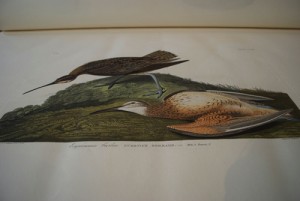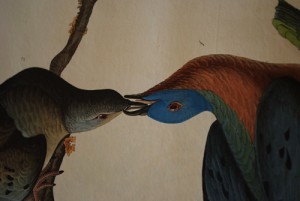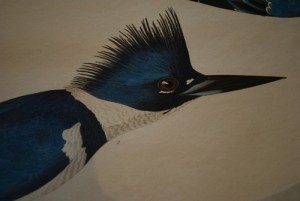
Last Friday afternoon I spent two hours in the company of one of my childhood heroes. I
didn’t know much about him when I was seven or eight, but I did know his pictures of birds,
reproduced in books and magazines about ornithology, and all the more wonderful to me
because they depicted birds from another world, America. Leaning on the kitchen table,
with my tongue sticking out of the corner of my mouth for extra concentration, I made
attempts to copy his pictures, in crayons on pages of exercise books. And I dreamed of
seeing some of those birds, as delightful and exotic to me as unicorns. When I finally went
to North America when I was 18, seeing ordinary ‘back yard’ birds like American robins,
red winged blackbirds, flickers and blue jays was doubly thrilling to me because I’d seen
them in Audubon’s pictures.
So when the lovely Louisiana State University curator e mailed me to say that no, the
collection of Audubon elephant folios wasn’t open to the public, but that I could make an
appointment to see them, my heart did what my seven year old self knew as ‘roly-polys’.
I made my appointment for April 26th, and on Friday I walked from the scented afternoon
sunshine of the LSU campus, into the high ceilinged library where the three folios lay like a
giant’s picture books, on trolleys, cradled in shallow v shaped holders to protect the spines
as the pages were turned. I had two hours.

It was magical and strange. Two hours to look at hundreds of pictures. Not two hours to sit
and stare at one. I turned pages, lingered too long, passed over too fast, gasped, smiled,
almost cried.
Lots of things went through my mind as I drank in the images. First of course was the
sheer technical rigour: feathers that make your fingers want to stroke them. A single
detached feather on the peregrine page elicited an automatic brushing motion from me as
I tried to remove the ‘real’ feather that looked as if it had landed on the page. The feet of
the smaller birds particularly struck me…small birds toes are extraordinary, tiny but long
and articulate, able to wrap and hold with astonishing strength. Anyone who has ever put a
ring on a bird’s foot knows their strange, delicate, knobbliness. As I looked at the feet of
Audubon’s birds I felt blue tit feet gripping my fingers, felt merlin chicks toes as I pushed
them through a pullus ring, remembered the way a tawny owl fledging had opened my
finger almost to the bone with the touch of a single claw. Of course I realised then why this
tactile feeling is so strong in Audubon’s work: he knew his subjects by touch as intimately
as by sight, no binoculars in those days, he drew from shot specimens, which he
preserved and posed, so every tiny detail of their anatomy was familiar to his fingers and
his eyes. The attention Audubon paid to the detail available to him was fanatical, not only
in the birds but the vegetation and insects and reptiles he puts in the pictures with them: a
tiny money spider floating from the top of a frame; the curling caterpillar eaten leaves of a
tree. And all the detail was put in the context of his observations of the living creatures, so
that tells some small story about the bird’s life, habitat, behaviour. His pictures don’t just
give identification, they give life history; each image is a piece of narrative non fiction.
Some of the poses capture tiny moments of behaviour, prefiguring images not seen again
until the advent of high speed cinematography. He captures the essence of bird-ness: the
way the insubstantial fluff of feathers creates weaponry, display, armour; their quickness,
the speed with which they move and communicate; the way beaks and feet are shaped to
sometimes gruesome tasks. Audubon’s birds are often beautiful but never
anthropomorphised into something pretty, they are always living creatures in all their
vividness and utility.
Not only are the pictures zoologically astonishing but aesthetically ravishing. Who would
have thought there were so many ways of showing ‘bird’? The variety and invention of his
compositions, their range of scale and of palette is soberingly impressive. He never let’s
up. The energy of the man is almost frightening. That’s before you even start to consider
the story of how he published his work, by tireless promotion, especially in the UK, and
the acquisition of subscription to fund the making of the plates and their hand colouring.
Audubon knew the value of casting a brand.
Not every species is perfectly represented. He clearly had favourites that he knew best.
The woodland species I think are loveliest – woodpeckers I think he loved especially. But
he has blind spots: his owls are, well, a bit rubbish. Perhaps because he worked from
dead specimens where the disk of the owl face is lost a little, his owls are a bit hawkish or
have eyes not set quite in the right place.
I met old friends amidst the lovely storm of new images. I turned a page and came across
an old favourite, his Eskimo curlews. I love them for so many reasons: because the way
one bird is rolling around with such comfort and pleasure; because curlews are lovely to
me and the picture reminds me of walking over a stubble field into a full yellow moon with
live curlews in my arms ; and because Eskimo curlews are extinct. Audubon’s pictures
of things alive a hundred years before me and now gone fired my youthful ambition to
become a biologist and an evangelist for the wild. Turning a page on Friday and seeing
passengers pigeons courtship feeding was a chilling reminder that extinction is a threat to
even the most abundant species.
I left the library exalted and exhausted but with a thirst to see real birds. So today I drove
out of town away from the endless spaghetti junction of roads that wraps Baton Rouge
in traffic, to the green, green, green of Louisiana forest and swamps. It wasn’t a totally
successful expedition, it’s early in the year and many walking trails are still flooded from
the March swelling of the Mississippi, but I did see cardinals, and indigo buntings, robins,
and mocking birds (my new favourite bird) blue jays and red headed woodpeckers, and
an owl, fat and brown and downy flapping lazily in broad daylight. Sitting in the garden of
Oakley Plantation where Audubon once sat I saw a humming bird, a female ruby throat
I think, vibrating amongst the flowers as if she was thinking herself to flight. She was
so small, not bigger than my little finger but there was so much life concentrated in her,
she glowed and thrummed with it. That, I think, is what John James Audubon must have
been like, glowing and thrumming with intense life. He would be too much for our watered
down modern world, un editable, irrepressibly himself. He was truly a force of nature and
I will think of him, forever walking in the deep green of the forests that he loved with such
passion.

